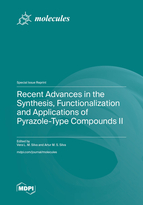Recent Advances in the Synthesis, Functionalization and Applications of Pyrazole-Type Compounds II
A special issue of Molecules (ISSN 1420-3049). This special issue belongs to the section "Organic Chemistry".
Deadline for manuscript submissions: closed (31 December 2022) | Viewed by 34618
Special Issue Editors
Interests: organic synthesis; development of sustainable organic synthesis methodologies; ohmic-heating-assisted synthesis; synthesis, functionalization and structural characterization of oxygen- and nitrogen-based heterocyclic compounds; development of molecules for medicinal applications
Special Issues, Collections and Topics in MDPI journals
Interests: organic chemistry; green synthetic organic chemistry; synthesis of heterocyclic compounds; natural products; NMR techniques; synthesis of new compounds with biocidal and antioxidant activities
Special Issues, Collections and Topics in MDPI journals
Special Issue Information
Dear Colleagues,
Pyrazoles are considered privileged structures in medicinal chemistry due to their remarkable biological activities and occurrence in many low-molecular-weight compounds present in several marketed drugs (e.g., Celebrex® and Viagra®). Pyrazoles are also found within a variety of agrochemicals (fungicides, insecticides, and herbicides) and are versatile scaffolds for synthetic manipulations. The structural features of pyrazoles (mainly tautomerism, with possible implications for their reactivity), as well as their diverse applications, have stimulated the work of several research groups towards the synthesis and functionalization of pyrazole-type compounds and the study of their properties.
This Special Issue aims to provide a broad survey of the most recent advances in pyrazole chemistry. Original research articles or reviews that discuss new organic reactions and methodologies for the synthesis and functionalization of pyrazoles (including their reduced forms, pyrazolines), their use as ligands for the preparation of complexes, structural aspects and properties, and their applications in different fields are welcome.
Dr. Vera L. M. Silva
Prof. Dr. Artur M. S. Silva
Guest Editors
Manuscript Submission Information
Manuscripts should be submitted online at www.mdpi.com by registering and logging in to this website. Once you are registered, click here to go to the submission form. Manuscripts can be submitted until the deadline. All submissions that pass pre-check are peer-reviewed. Accepted papers will be published continuously in the journal (as soon as accepted) and will be listed together on the special issue website. Research articles, review articles as well as short communications are invited. For planned papers, a title and short abstract (about 100 words) can be sent to the Editorial Office for announcement on this website.
Submitted manuscripts should not have been published previously, nor be under consideration for publication elsewhere (except conference proceedings papers). All manuscripts are thoroughly refereed through a single-blind peer-review process. A guide for authors and other relevant information for submission of manuscripts is available on the Instructions for Authors page. Molecules is an international peer-reviewed open access semimonthly journal published by MDPI.
Please visit the Instructions for Authors page before submitting a manuscript. The Article Processing Charge (APC) for publication in this open access journal is 2700 CHF (Swiss Francs). Submitted papers should be well formatted and use good English. Authors may use MDPI's English editing service prior to publication or during author revisions.
Keywords
- pyrazoles
- pyrazolines
- synthesis
- functionalization
- transformation
- complexes
- applications








